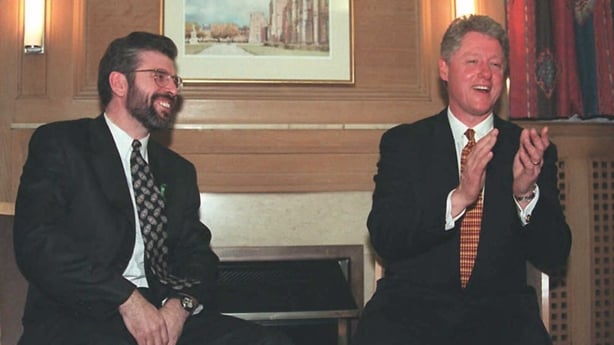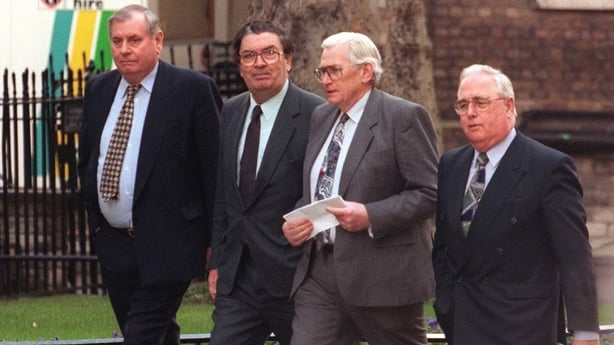By David McCullagh and Fiachra Ó Cionnaith
The critical importance to the Peace Process of Sinn Féin fundraising in the United States was highlighted by Gerry Adams early in 1995, just as the issue was causing a huge row in Washington, according to the newly released Government files.
In a discussion with senior Department of Foreign Affairs official Seán Ó hUiginn in February 1995, the Sinn Féin leader said there was a danger of a return to violence if the present strategy was not seen to be working.
Mr Adams said that the ceasefire had been "sold" to republicans on the basis of there being "three pieces of the jigsaw", the relationship with John Hume, the commitment of the Fianna Fáil and Labour government and what he called the Irish-American dimension.
Mr Hume was still in place as leader of the SDLP, but the government in Dublin had changed, with Albert Reynolds replaced as taoiseach by John Bruton, while "the United States was not delivering on an issue as basic and important as fundraising".
This was because his visa to visit the United States, issued the previous year, did not allow him to raise funds for Sinn Féin.
He told Mr Ó hUiginn that the visa was due for renewal the following month and he hoped the fundraising restrictions would be waived.
However, when Tony Lake, US president Bill Clinton's national security adviser, wrote to attorney general Janet Reno seeking to have the fund-raising ban lifted, he got an angry response.
Ms Reno pointed out that she had looked at the issue in January and was being asked to consider it again just six weeks later.

This was premature, she said, and in any case, the conditions she had set for lifting the ban had not been met, an end to IRA arms procurement and "concrete progress toward disarmament and demobilisation".
Not only had no progress been made on meeting these conditions but she was also aware of evidence that the IRA had continued to identify possible sources of arms, and "to make enquiries concerning availability and terms of purchase".
She added that the US Departments of Justice, State and Treasury were committed to tackling international terrorism and that "these collective efforts could be undermined by removing the Adams visa restrictions at this time".
Read more:
Netanyahu lobbied for Dublin embassy, State Papers show
SF, govt had 'sharp exchange' over criminality comments
Weapon manufacture proposals rejected by separate govts
State Papers: Six more things we learned
Iran offered 'secret meeting' to help free Brian Keenan
However, after Sinn Féin announced its willingness to discuss decommissioning with the British government, the White House overruled Ms Reno and granted a visa which allowed Mr Adams to raise money, on the understanding that it would be used "for legitimate political party purposes which serve to reinforce Sinn Fein’s commitment to the peace process".
The Sinn Féin leader was also invited to the White House for the St Patrick’s Day reception.
Tony Lake told Mr Ó hUiginn of his "strong surprise" at the "over-the-top British reaction" to this, including prime minister John Major refusing to take a call from president Clinton.
Another of Mr Adams’ jigsaw pieces was the relationship with SDLP leader John Hume, who is rightly recognised for his key role in the peace process, and for the risks he took for peace.
However, one of the things he put at risk for the Peace Process was his own party, much to the annoyance of his senior colleagues.
The SDLP’s deputy leader Seamus Mallon told the Irish embassy in London in March 1995 that he had had a "heart-to-heart conversation with his party leader, which he believes had helped to clear the air between them".

Mr Mallon told Mr Hume he had no wish to challenge him for the leadership of the SDLP, but he told his leader that he should ease up on his "hand-holding" of Sinn Féin and concentrate on his own party’s political position.
Mr Mallon drily added that he thought Mr Hume "was disinclined to heed the advice".
South Down MP Eddie McGrady had similar concerns, telling John Hume that he had to decide "which of the two parties he was leading".
Mr McGrady was worried about an increasing political threat from Sinn Féin, which was now "infiltrating" his own constituency, where it had barely existed before.
It would take until 2017 for Sinn Féin to win the South Down Westminster seat from the SDLP.
Mark Durkan, one of Mr Hume’s close colleagues in Derry, reported that SDLP activists were worried about the level of publicity Sinn Féin was receiving and at the success of Gerry Adams at fundraising in the United States.
Mr Durkan reported that he was trying to persuade Mr Hume to appoint an SDLP coordinator in the US to raise money for the party.
However, Mr Hume remained totally committed to helping the Sinn Féin leadership and keeping in close contact with them.
He told Seán Ó hUiginn that Gerry Adams and Martin McGuinness had "put their heads on the line" to get an IRA ceasefire, and that "it was vital they should not be undermined".
For Mr Hume, the Peace Process came first, whatever the cost.
[Based on documents in 2024/28/10, 2024/28/13 and 2024/28/16]

